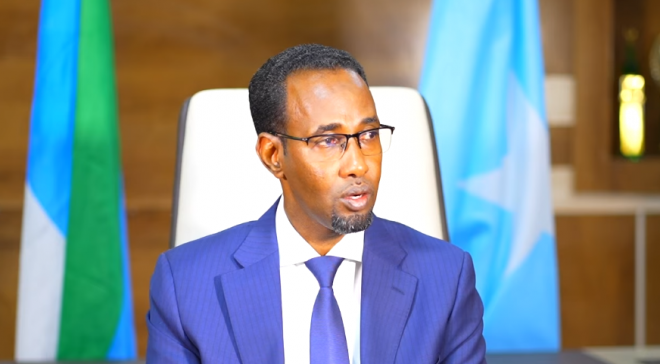Despite Billions in Aid, Somalia’s Army Crumbles as Al-Shabaab Resurgence Gains Ground, Donors Losing Faith
MOGADISHU, Somalia - Despite billions of dollars in international support, Somalia’s army has melted in the face of a months-long offensive by the Al-Qaeda-linked Al-Shabab insurgency, and donors are running out of patience.
Using hundreds of fighters and a vehicle packed with explosives for a suicide attack, Al-Shabab retook the town of Moqokori on July 7, the latest in a wave of defeats this year for the government.
It has given them a strategic geographical position to launch attacks into the Hiiraan region. Still, it was also a powerful symbolic victory over a local clan militia that had been the government’s “best fighting force” against Al-Shabab, according to Omar Mahmood of the International Crisis Group.
Somalia’s government has been battling the Islamist militant group since the mid-2000s, and its fortunes have waxed and waned, but now faces a perfect storm of declining international support, a demoralised army and political infighting.
The government relied on local militias, known as “Macwiisley,” for a successful campaign in 2022-23, taking some 200 towns and villages from Al-Shabab.
However, the insurgents' counteroffensive this year has seen them regain approximately 90 per cent of their lost territory, according to Rashid Abdi of Sahan Research, a think tank.
Towns that were supposed to be models of stabilisation, such as Masaajid Cali Gaduud and Adan Yabal, have fallen. Three bridges along the Shebelle River, crucial to military supply lines, have been destroyed.
“The whole stretch from the north-west to the south-west of Mogadishu is now controlled largely by Al-Shabab,” Abdi told AFP.
The Macwiisley campaign collapsed, he said, because the government of President Hassan Sheikh Mohamud, known as HSM, “was extremely inept at working with the clans,” empowering some and not others based on political favouritism rather than military needs.
“The mobilisation went well when the president came from Mogadishu to start the first phase of the offensive (in 2022). Everybody was heavily involved in the fighting… assisting the national army,” Mohamed Hassan, a local militia member in Hiiraan, told AFP.
“It’s no longer the same because the leadership are no longer involved and there seems to be disorganisation in how the community militias are mobilised,” he added.
The Somali National Army has done little to stem the insurgents, unsurprising for a force “still in development mode while trying to fight a war at the same time,” said Mahmood, the analyst.
Its most effective arm, the US-trained “Danab” commando unit, is better at killing militants than holding territory, and has suffered demoralising losses to its officer corps, added Abdi.
“We are beginning to see an army that is not just dysfunctional, but losing the will to fight,” he said.
The problems stem from the wider chaos of Somali politics, in which a kaleidoscope of clan demands has never resolved into anything like a national consensus.
The government has vowed a renewed military push, but President Mohamud’s focus has been on holding the country’s first-ever one-man, one-vote election next year.
That will not happen,” said a Western diplomat, speaking on condition of anonymity. Even in Mogadishu, where security is strongest, “any polling station would get bombed,” he said.
“Unfortunately, attention was shifted toward insignificant politically related matters, which do not help security, instead of focusing on strengthening the armed forces,” ex-president Sharif Sheikh Ahmed recently told reporters.
Al-Shabab has not launched a full assault on the capital, but has repeatedly demonstrated its presence.
Pot-shots targeting the airport are at an all-time high, said the diplomat, and Mohamud narrowly survived an attack on his convoy outside the presidential palace in March.
The group also controls much of the economy.
“It out-taxes the state. Its business tentacles spread everywhere,” said Abdi. “It is one of the wealthiest insurgencies in Africa.”
Meanwhile, the government’s foreign backers are losing patience.
The European Union and United States have poured well over $7 billion into Somali security — primarily various African Union-led missions — since 2007, according to the EU Institute for Security Studies.
The previous AU mission ended in December, but had to be immediately replaced with a new one — with the quip-generating acronym AUSSOM — because Somali forces were still not ready to take over.
“There’s a huge amount of donor fatigue. People are asking: ‘What have we bought for the last 10 years?’ Seeing the army run away and having to create) AUSSOM was hard for people,” said the diplomat.
Donors, especially Washington, are reluctant to keep funding the AU mission.
Mahmood estimates it will scrape together two-thirds of its funding for 2025: “Enough to keep things going… but there’s a chronic shortfall.”
Somalia has struck deals with newer partners like the United Arab Emirates, Qatar and Egypt. Turkiye has deployed about 500 troops, backed by drones, to reinforce security in Mogadishu.
But they are interested in protecting investments such as a mooted Turkish spaceport, said Mahmood, rather than leading the fight against Al-Shabab.
“We are staring at a very grim situation,” said Abdi.
Source: AFP








